- Flowers
Flower Bulbs Allium Bulbs Anemones Begonia Tubers Crocus Bulbs Daffodil Bulbs Dahlia Tubers Hyacinth Bulbs Lily Bulbs Tulip Bulbs Woodland Flower Bulbs Other Flower BulbsFlower Plants Annual Bedding Plants Children's Flower Plants Clematis Climbing Plants Cottage Garden Plants Exotic Plants Flowers For Cutting Plants Foliage Plants Greenhouse & Indoor Plants Ground Cover Plants Hanging Basket Plants Lavender PlantsHardy Geraniums Herbaceous Border Plants Heuchera Pansies and Violas Patio Plants Water Plants Window Box Plants Winter Bedding Plants Hydrangea Large impact plants Recommended By Our Experts
- Fruit & Vegetables
- Trees, Shrubs & Ornamentals
- House Plants
- Tool Shed
Garden Tools & Equipment Barrows and Trolleys Garden Solutions Harvesting Plant Supports Seed Sowing Tree Stakes Water Butts Weed Control Hand Tools Secateurs, Snips and Pruners WorkshopGarden Irrigation & Watering Irrigation Kits Water Butts Hoses & Sprays Miscellaneous Fertilisers Plant Pots Hanging Baskets Plant Protection Garden Compost All Compost
- Outdoor Living
Garden Living Barbecues & Firepits Garden Storage Solar Lights & Lighting Fixtures & Ornaments Awnings Sail Shades Garden Clocks Landscaping Lawn Edging PavingPatio Heaters Gas Patio Heaters Electric Patio Heaters Fire Pits, Chimeneas, Fire Baskets Wallmounted/Ceiling Patio Heaters Freestanding/Table Top Patio Heaters Water Features Solar Powered Water Features Mains Powered Water Features Indoor Water Features Outdoor Water FeaturesGarden Furniture Rattan Furniture Parasols Garden Benches Dining Sets Loungers Wooden Furniture Party Tents & Gazebos
- Wild Birds
- Gardening Info
- Special Offers
Join Our Gardening ClubVan Meuwen Gardening Club
Become a Member
Join our Gardening Club to unlock exciting perks and discounts!
JUST £10 for one year's membership
10% OFF EVERY order placed online £20 worth of Van Meuwen Vouchers Exclusive members only deals Join NowHow to plant and grow garlic
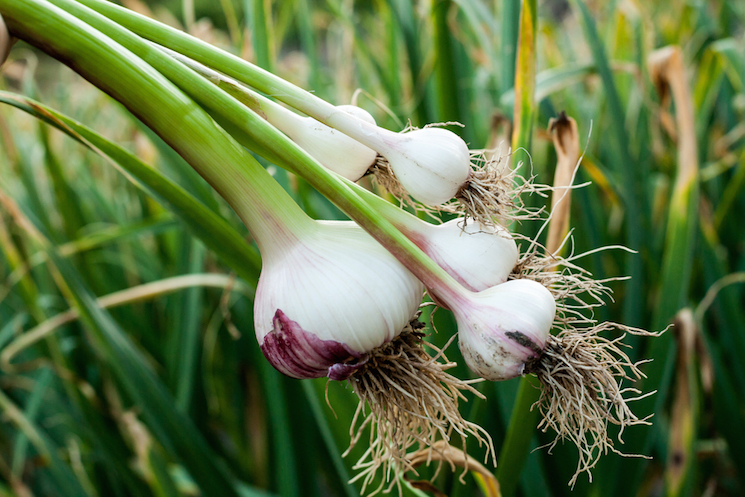
Home grown garlic tastes better than anything you can buy in the supermarket
Image: ShutterstockGarlic is a staple ingredient in many of our favourite dishes, and it tastes even better when it comes fresh from your own garden. It’s easy to grow, doesn’t need a great deal of space and is relatively foolproof if you’ve never grown it before.
Don’t be tempted to try planting the bulbs you buy from the supermarket – they’re prone to disease and are often unsuitable for our climate. For healthy and successful plants, buy quality garlic bulbs from an online supplier or pick some up from a local garden centre.
There are two main varieties of garlic – Hardneck or Softneck. Hardneck varieties produce flower stems known as ‘scapes’, which can be used in salads and stir-fries in addition to the bulbs themselves. They don’t store as well as Softneck varieties but they’re thought to be more flavoursome.
Softneck garlic is the variety you’re likely to find in the supermarket, and has a milder flavour and significantly longer shelf-life. This variety does not flower.How to plant garlic
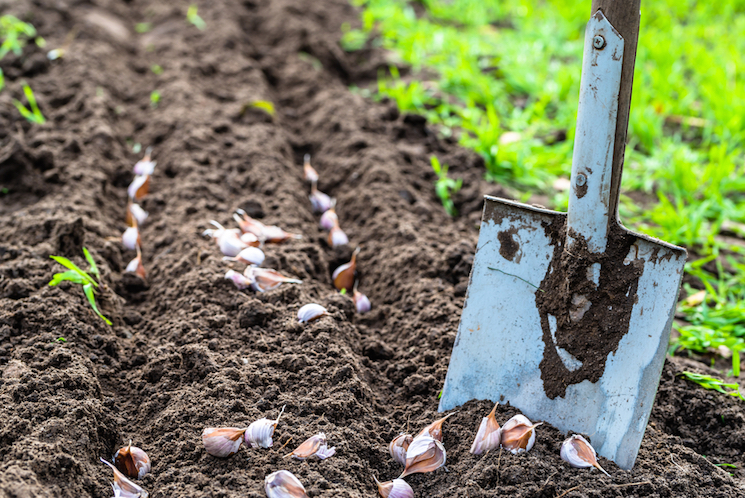
Sunny areas with good drainage are best
Image: ShutterstockThe best time to plant garlic is October to February, but many experienced gardeners believe you get a better crop by planting in the autumn. Be sure to check the packet for variety-specific advice.
The ideal growing environment is a sunny, well drained area, protected from birds. Make sure the soil has not been recently used for garlic, and has been mixed with good compost and allowed time to rest.
Break the bulb apart into cloves just before planting, taking care not to bruise them. These should be planted about an inch deep and approximately six inches apart. Bury them root downwards, with the points facing up.Common garlic growing problems
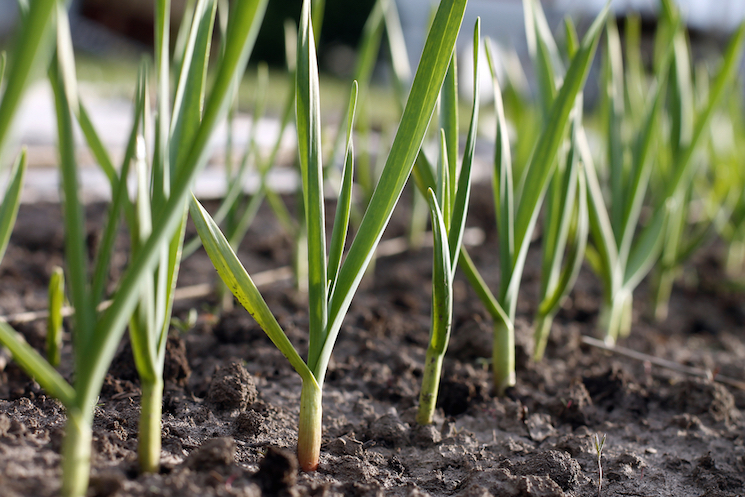
Regular weeding is a must
Image: ShutterstockGarlic will need watering during drier periods of spring and early summer, but hold off in the weeks leading up to harvest when the bulbs are well-formed. The leaves will start to yellow as the time to lift your crop approaches. Cut any flowers that form and keep the area free from weeds.
Garlic is easy to grow, but there are two main problems that you’ll need to keep an eye out for. If either of these infections occur, dispose of infected plants and don’t grow garlic, leeks or onions in the same spot for at least three years. The two most common problems are:
White rot
This is a fungus that can attack growing bulbs. It’s identifiable by the yellowing and wilting of the leaves, and causes decay of the roots and later the bulb. Once white rot has set in there’s no way to get rid of it, so prevention is best. It’s caused by contaminated soil so be extra careful in allotments, where cross-contamination can easily occur.
Rust
Rust is another fungus, and causes yellow spots to form on the leaves. It’s usually worse in long spells of wet weather and soil with poor drainage. Mild attacks of rust won’t really be a problem, but if it becomes more serious it will affect the yield. Like many fungal infestations, it isn’t really possible to get rid of it once it’s present in the soil. One way to help avoid infection is to leave adequate space when planting, as bulbs forming too close together increase soil humidity.When to harvest garlic
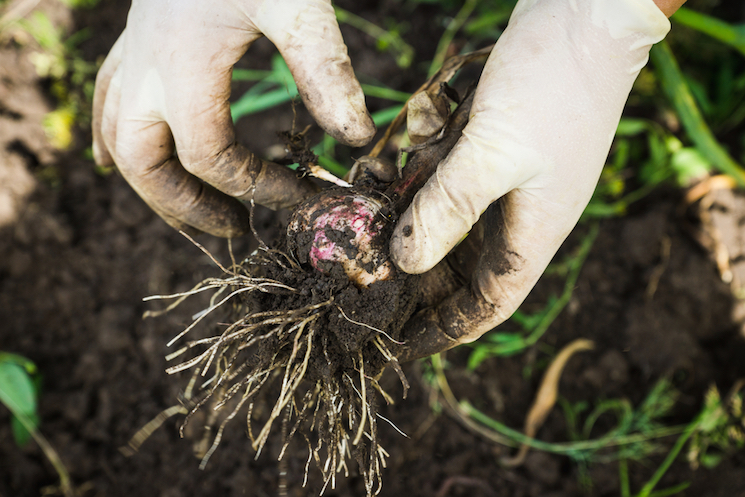
Excess dirt will easily come away from the bulbs when dried
Image: ShutterstockHarvesting is best done between May and June, but will depend on the variety so make sure to check the packet. Harvest too early and you’ll miss the final growth spurt, but leaving garlic in the ground for too long can cause the bulbs to rot.
The leaves of Hardneck varieties can be cut when green and used as a garnish, in salads, or as part of a delicious homemade pesto. The bulbs are harvested later, once the leaves have begun to yellow.
Carefully lift bulbs out, brushing dirt off with your hands. Lay them out to dry in an airy place until they rustle, which means they are ready to store and use.
Why not have a go at growing your own stock of this cupboard staple? Garlic is easy to grow and once harvested can be used as a versatile ingredient for many well-known dishes.Quick Links:
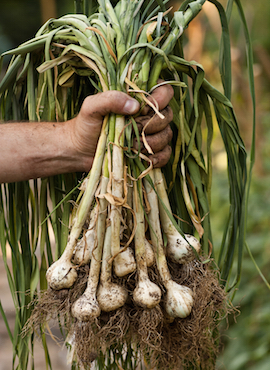
Harvesting garlic, depending on the variety, is best done between May and June.
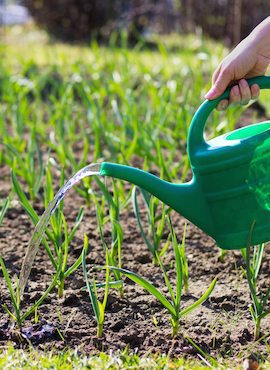
Hold off watering in the weeks leading up to harvest, however, garlic will need watering during drier periods of spring and early summer.
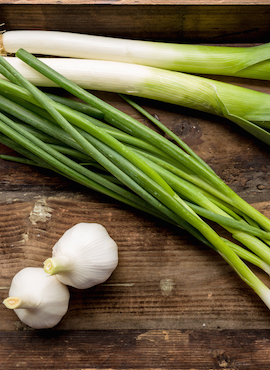
If your patch has been infected by white rot or rust then dont grow garlic, leeks or onions in the same spot for at least three years.
Sign up to the Van Meuwen Gardener's Club for Special Offers
Delivery Information Privacy Policy Cookies Terms of Business Affiliate Programme Planting & Cultural Advice Contact Us© 2025 Van Meuwen. All rights reserved. A division of Branded Garden Products Limited.
- House Plants
